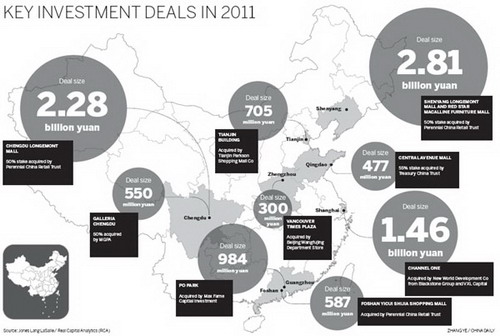 |
|
|
|
|||||||||

Big real estate openings expected in fast-growing second-, third-tier cities
Retail property remains the darling of investors as authorities continue their rigorous policies in the residential sector, but more eyes are turning to the country's second- and third-tier cities, analysts have said.
International real estate service provider Jones Lang LaSalle (JLL) predicted that retail would provide the greatest real estate opportunity in China's 50 major cities.
In the China 50, a recent in-depth research report assessing the nature of real estate opportunities beyond China's biggest cities, JLL mapped out the country's emerging business locations to identify the drivers that are shaping the city hierarchy.
"These 50 cities combined are expected to account for 12 percent of overall global economic growth over the next decade," said Michael Klibaner, head of research for JLL China.
Klibaner said the 50 cities contain all of the world's 10 fastest-growing large cities, led by Chongqing, Tianjin and Chengdu.
"These numbers are a clear signal that China 50 abounds with one of the world's most exciting real estate opportunities," he said.
Investor appetite for retail real estate increased substantially with total investment volume reaching about 26.5 billion yuan last year ($3.2 billion), according to JLL. That is an impressive figure given the challenging liquidity conditions in the broader economy, analysts said.
Chinese and Asian capitals dominated the market with 90 percent of acquisitions. Among the foreign investors, Singapore-listed groups were the most active with a third of all investments, JLL statistics showed.
"Accounting for 79 percent of total volumes, Chinese groups were major sellers last year, and this trend will likely carry forward in 2012," said David Hand, head of China Investment at JLL .
The shopping center format continued to gain popularity with an overwhelming 86 percent of investment capital, favoring the format over department stores. In particular, shopping centers in second-tier cities have been gaining market share at a faster rate than the first-tier cities.
"China's retail sector is poised for a major upgrade," said Mark Ho, head of China Investment Research at JLL. "The government has already set in motion a comprehensive range of pro-consumption policies, both direct and indirect, to orchestrate a consumption boom. The impact from these measures is expected to filter through over the next few years and will effectively give China's retail sector a structural boost."
Hand said more investors are targeting opportunities in relatively less mature cities where the impact of urbanization and income growth is expected to feature prominently.
"As other investors come to recognize the permanent changes unfolding in China's retail sector, more are expected to follow with a heavier weighting toward the sector," Hand said.
Chinese and Asian investors led the charge in investing beyond the country's biggest cities. As retail markets in lower-tier cities remain at a relatively early stage, many opportunities are being seen in development projects.
Chinese and Asian capitals, with more market familiarity and a higher risk-appetite, are leveraging on their competitive advantages of better deal access and local market knowledge to expand aggressively.
On the sell side, Chinese sellers dominated as the bulk of retail properties remain in the hands of these groups, especially in lower-tier cities. But with more foreign investors going into retail assets, the sellers' market is expected to broaden in a few years as these assets reach maturity.
JLL expects the evolution of China's retail sector to accelerate over the next few years as China's economic transformation gathers momentum.
The increase in investment across China would lead to further broadening and deepening of the retail real estate sector. The retail landscape is also rapidly changing as new and modern shopping centers emerge in cities across China.
Department stores were the dominant format in second-tier cities as recent as five years ago, but shopping centers have now overtaken them in terms of market share.
"We are still in the early days of the economic transformation process and expect to see more investment opportunities emerge as China's retail sector develops at a faster pace," Hand said.
Fan Xiaochong, vice-president of Sunshine 100, said at a recent Soufun forum that property developers have to restructure their business to deal with market correction.
"The game rules and profitability mode in China's property development have been changed and the high-growth period is over for property developers," Fan said. "Compared with the residential sector, there is still huge growth potential for commercial properties in the country's second- and third-tier cities."
Over the past three years, China has emerged as a major commercial real estate investment market, with direct investment volumes doubling from $8 billion in 2008 to more than $17 billion in 2011, statistics from JLL showed.
China now ranks as the world's sixth-largest real estate investment market, behind the United States, United Kingdom, Japan, Germany and France, an impressive growth story given that an active investment market only started to build in 2005.
Thomas Lam, head of Greater China Research at Knight Frank, said he foresees abundant growth potential in China's retail sector in the first half of 2012 and expects it to outperform the office and residential sectors.
Lam believes retail rents and prices will have double-digit growth in 2012, with the highest growth likely to be in Shanghai.
huyuanyuan@chinadaily.com.cn